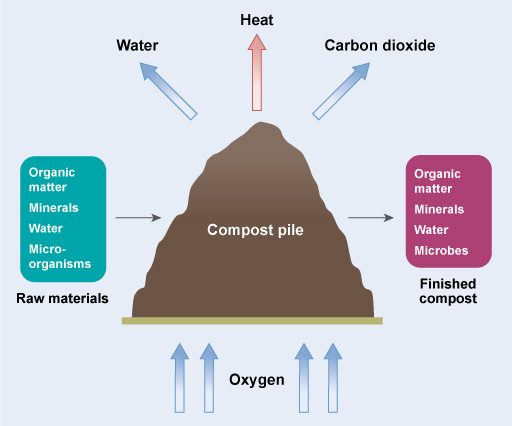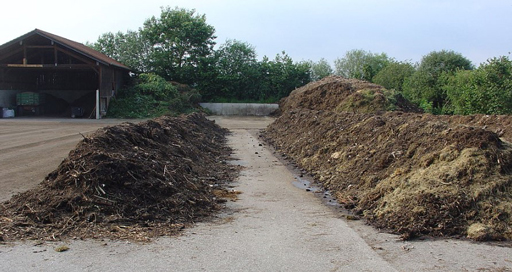8.5.2 Composting
Composting is the process where biodegradable organic wastes (food and garden waste) are converted into compost in a natural biological process. Composting can be done by individual householders and community groups or on a commercial scale. On the larger scale, the waste from an entire town or city could be composted if sufficient land, labour and equipment is available. The benefits of composting are not only the reduction of waste, but also the production of compost which is a valuable soil improver. Soils treated with compost are better able to withstand droughts and are more fertile because plant nutrients are returned to the soil, which reduces the need for manufactured fertilisers. It is possible to add a certain amount of animal manure to residential waste for composting, which may help with other waste problems in the community and adds to the amount of useful soil improver that is made.
Refer back to Table 7.1 in Study Session 7 and estimate what proportion of the municipal waste from urban areas can be composted.
According to the data in Study Session 7, municipal waste contains 44% food waste and 12% garden waste making a total of 56%, so more than half of the waste can potentially be composted.
As an urban WASH worker you may be required to help individuals or communities set up and operate composting processes (Figure 8.4). The stages in the composting process are outlined below.

- Separation of compostable materials: It is important to begin with an uncontaminated input to the process. Nearly all organic wastes can be composted, but if a composting pile attracts rodents and other scavenging animals it may be better to exclude meat products and cooked food from the process and just collect garden waste and raw vegetable waste.
- Grinding or shredding: To speed up the composting process it may be necessary to shred the raw waste before placing it in the compost pile. Shredding is normally required if a significant proportion of the waste has particles greater than about 50 mm. On a domestic scale this can be achieved simply by cutting up the waste into smaller pieces.
- Blending or proportioning of materials: Composting works best with the right mixture of wastes so that the moisture content and the proportions of the chemical elements carbon and nitrogen are suitable. Generally, the ideal mix for composting is three parts (buckets, for example) of ‘brown’ waste (such as leaves, hay, straw, eggshells, shredded paper, card and woody material), with one part ‘green’ material (such as grass, food waste and animal manure). ‘Brown’ waste contains a higher proportion of carbon and ‘green’ waste, contains more nitrogen and has a higher moisture content. Thus the ratio of brown waste to green waste is 3:1.
- Composting: Composting is normally carried out in a pile. For larger scale composting processes, piles are in the shape of long rows of waste, normally with a triangular cross-section (Figure 8.5). The ideal pile is 1.5–2 m wide and about 1.5 m high. The length of the pile is determined by the space and the amount of waste available. On the domestic scale the pile will be much smaller, forming a rounded heap. The pile can be built up as waste becomes available, but it is important to have enough material present to allow the biological processes to take place reasonably quickly, so as a guide a domestic compost heap should be at least 1 cubic metre to start the process.

Composting is an aerobic process, so the pile needs to be turned regularly to introduce air. This means dismantling it, mixing the waste to introduce air and then rebuilding the pile. The first turning-over of the heap should be done after two to three weeks and then every three weeks or so. The composting process will be complete within three to six months. The composting process generates heat, so it is normal to see steam coming out of the pile.
The process is complete once the pile no longer heats up after mixing and rebuilding. The final product should be brown and crumbly and look like a good soil. If it still contains identifiable items, the process is not complete.
Summarise the advantages of composting.
Composting provides an effective and safe way of disposing of a large proportion of a community’s waste that doesn’t involve specialised or costly equipment. It provides a valuable product that can be used by the community to improve the quality of its vegetables while reducing the need to buy fertilisers. Other wastes, such as animal manure, can also be added to the composting process.
8.5.1 Waste separation
